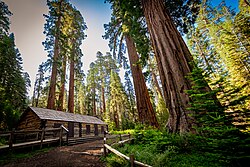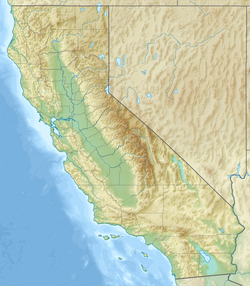Mariposa Grove Museum
Mariposa Grove Museum | |
 The Mariposa Grove Museum | |
| Nearest city | Wawona, California |
|---|---|
| Coordinates | 37°30′50″N 119°35′54″W / 37.51389°N 119.59833°W |
| Area | 1 acre (0.40 ha) |
| Built | 1930 |
| Architect | National Park Service |
| Architectural style | Rustic |
| NRHP reference No. | 78000381[1] |
| Added to NRHP | December 1, 1978 |
The Mariposa Grove Cabin, originally built in 1864 by Galen Clark, Yosemite's first guardian and discoverer of the Mariposa Grove, stands as an iconic symbol of Yosemite National Park. Located near the General Grant and General Sheridan trees, the cabin has been rebuilt three times on the same site, with the current structure dating to 1931.[2] Although not an exact replica of the original, the cabin reflects a blend of Rustic style and minor Art Deco styles, showcasing natural materials and skilled craftsmanship.[2]
In 1978, the Mariposa Grove Cabin was listed on the National Register of Historic Places.[1][3]
Galen Clark Cabin
[edit]Clark constructed the first shelter, a simple one-room cabin, in the Upper Grove in May 1864, shortly after being appointed the first guardian of the Yosemite Valley and Mariposa Big Tree Grant. He used it as an office and information center for visitors. In June 1864, Dr. Henry Bellows named it "Galen's Hospice" after his party took shelter there during a storm.[4][2]
In 1881, the State of California replaced the ramshackle building with a new one room cabin.[5][2] Another room was added in 1902 to serve as the office for the grove's guardian.[6][2]
Galen Clark's cabin became a symbol of early Yosemite tourism, serving as a lunch stop for stagecoach trips to Mariposa Grove operated by the Yosemite Stage and Turnpike Company.[7]
Visitors often took photographs of the cabin, surrounded by towering giant sequoias, and these images were widely used in promotional materials.[4][6]
In 1917, plans by the federal government to demolish the historic cabin to build a hotel sparked widespread protests. The California Legislature passed a resolution calling for its preservation, and visitors rallied to save it as a symbol of the state's heritage.[8] Ultimately, the cabin was protected and the Camp in the Big Trees, which featured overnight accommodations, was built in a separate location in the grove.
Mariposa Grove Museum
[edit]The Mariposa Grove Museum stands on the site of the original Galen Clark Cabin. In 1930, the National Park Service built the current structure to display museum exhibits about the grove's history.[9][10][11]
It is a one-story log structure measuring 20 feet (6.1 m) by 45 feet (14 m) and divided into two rooms. It has a low-pitched gable roof covered with wood shingles, with a 24 inches (61 cm) exposure. The cabin is built from peeled sugar pine logs, laid in alternating tiers and interlocked at the corners and where the partition wall meets the exterior walls with a "V" notch joint. The spaces between the logs are filled with tightly fitted split-log wedges. A 45 by 12 feet (13.7 by 3.7 m) plank deck runs along the southwest side.[2]
An exterior chimney, made of granite in a coursed rubble pattern, is located on the southeast end. The southwest side has three double-hung, 6x6 windows, while the northeast side has two. There are three doors—two on the southwest and one on the northeast—made of vertical boards and decorated with large, false strap hinges of unpainted iron.[2]
Inside, the room is dominated by a rough-dressed granite fireplace in the shape of a segmented arch. The flooring is doweled, random-width oak. The main decorative feature is the handcrafted furniture, including massive sequoia wood tables and benches, hand-planed and polished, with simple, stylized carvings of Native American motifs reflecting an Art Deco influence.[2]
The cabin and its furnishings were designed to blend with the surrounding sequoias, with the massive furniture hand-hewn from a fallen sequoia in the lower grove.[12][2]
Ecological Research
[edit]In the mid-20th century, ecologist Richard Hartesveldt rephotographed the Galen Clark cabin from the same angles as hundreds of decades-old images.[13]: 204–207 This comparison revealed major changes to the sequoia grove since the time of discovery. His work showed that human activity and fire suppression allowed shade-tolerant white firs to proliferate, creating dangerous fuel buildup that threatened mature sequoias and stifled new sapling growth. Hartesveldt’s findings led forest managers to reintroduce natural fire cycles in giant sequoia groves, thereby changing the longstanding policy of fire exclusion.[14]
Gallery
[edit]-
Clark's one room cabin.
-
Galen's Hospice photographed by Carelton Watkins
-
Autos in front of Clark's Station.
Further reading
[edit]- Sargent, Shirley. Galen Clark: Yosemite Guardian. San Francisco: Sierra Club, 1964. Yosemite Nature Notes, Vol. 7, June 1932, pp. 4–5.
- Report of the Commissioners to Manage Yosemite Valley & the Mariposa Grove of Big Trees (1885–1886), p. 10, Yosemite Research Library.
- Superintendent Annual Reports, Yosemite National Park, 1928 & 1930, Yosemite Research Library.
References
[edit]- ^ a b "National Register Information System". National Register of Historic Places. National Park Service. July 9, 2010.
- ^ a b c d e f g h i "National Register of Historic Places Inventory - Nomination Form". United States Department of the Interior, National Park Service. December 1, 1978. Retrieved September 22, 2024.
- ^ Leslie Starr Hart (September 1975). "National Register of Historic Places Inventory/Nomination: Mariposa Grove Museum". National Park Service. and accompanying two photos and a map
- ^ a b "Galen Clark, Mariposa Grove Cabin". Yosemite Ranger Notes. National Park Service. April 12, 2013. Retrieved August 27, 2024.
- ^ Ditton, Richard P.; McHenry, Donald E. (1956). Self-guiding Auto Tour of Yosemite National Park. Yosemite Natural History Association.
- ^ a b "Galen Clark Cabin Will Be Opened Soon". Calexico Chronicle. Vol. XXVII, no. 223. 4 May 1931. Retrieved 16 September 2024.
- ^ Sargent, Shirley (April 1979). "A Stagedriver of 1915" (PDF). Yosemite Sentinel. Vol. Book V, Volume 4. p. 5. Retrieved November 18, 2024.
- ^ "Clark Cabin Should Be Preserved: Protest Filed Against Razing Little Home of Discoverer of Mariposa Grove of Big Trees". Morning Union. 10 February 1917. Retrieved 16 September 2024.
- ^ McFarland, James W. (1949). A Guide to the Giant Sequoias of Yosemite National Park. Yosemite Natural History Association.
- ^ Uhte, Robert F. (May 1951). "Yosemite's Pioneer Cabins". Sierra Club Bulletin. 36 (5).
- ^ "Galen Clark Cabin Will Be Opened Soon". Calexico Chronicle. Vol. XXVII, no. 223. May 4, 1931. Retrieved August 27, 2024.
- ^ "Mariposa Grove of Giant Sequoias - Yosemite National Park". U.S. National Park Service. Mailing Address: PO Box 577 Yosemite National, CA US. 95389 Phone: 372-0200. Retrieved 2019-11-06.
- ^ Tweed, William C. (October 1, 2016). King Sequoia: The Tree That Inspired a Nation, Created Our National Park System, and Changed the Way We Think about Nature. Heyday.
- ^ Richard J. Hartesveldt, H. Thomas Harvey, Howard S. Shellhammer, Ronald E. Stecker (1975). "Man, Fire, and the Future". The Giant Sequoia of the Sierra Nevada. U.S. Department of the Interior.
{{cite book}}: CS1 maint: multiple names: authors list (link)





